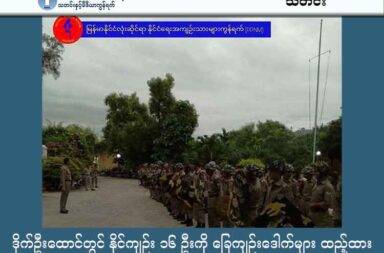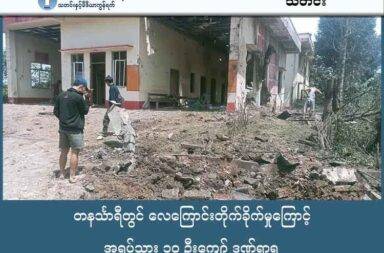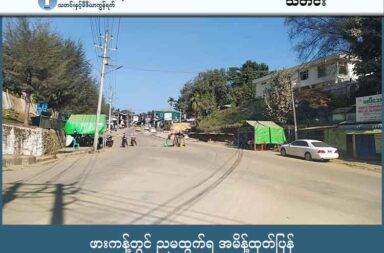Some IDPs in Northern Shan State Return Home
By NETWORK MEDIA GROUP (NMG)
Thursday, August 29, 2019
More than 3,000 people displaced by conflict in northern Shan State have returned to their villages to tend to their fields despite ongoing tensions in the region, according to local civil society organizations.
“Currently, more than 3,000 IDPs in Lashio and Hsenwi have already returned to their homes. There are still more than 2,000 IDPs in Kutkai. Villagers living along the Lashio-Mong Yaw road and in the northeastern part of Lashio have returned,” said Hawng Dau, a spokesperson for the Humanitarian Strategic Team—Northern Shan State (HST-NSS), one of several groups working with internally displaced persons (IDPs) in the area.
According to Hawng Dau, many IDPs have risked returning to their villages because they can’t afford to abandon their crops, which have been left untended since the current conflict began two weeks ago.
“Military tensions are still high in the Kyaukme, Hsipaw, Lashio and Muse areas of northern Shan State, though I think there are no clashes around their villages right now. They are farmers, so they have work to do in their fields,” Hawng Dau told NMG.
Relief workers say that the villagers’ decision to leave safe areas is worrying, because fierce fighting between government forces and an alliance of ethnic armed groups could erupt again at any time.
“There is no guarantee for their security. We don’t know when clashes will occur,” said Sai Su, a spokesperson for the Tai Youth Network, noting that recent statements from both sides in the conflict indicate that hostilities between them are still far from over.
According to Sai Su, a camp for IDPs in Hsenwi and Lashio townships is now nearly empty.
“There were fewer than 150 people in the camp as of yesterday [August 26]. Many have made the decision to return to the conflict area. The last batch left yesterday,” he told NMG.
While the number of IDPs in some areas has decreased, their ranks continue to swell in Kutkai, according to relief workers, who say that the affected population is desperate for more support.
“They still need a lot of assistance. We can only provide a few basics, such as rice, cooking oil, and salt. We don’t have any fresh vegetables for them. There are thousands of people. They still need many things,” said Hawng Dau.
The current crisis began earlier this month when the Ta’ang National Liberation Army (TNLA), the Arakan Army (AA), and the Myanmar National Democratic Alliance Army (MNDAA) mounted coordinated attacks on the Defense Services Technological Academy in Pyin Oo Lwin and other Burma Army targets in northern Shan State on August 15.
The joint forces reported that they engaged in seven clashes with the Burma Army in Lashio and Kutkai townships on Tuesday.
According to the report, the two sides exchanged fire near the village of Namkut; between the villages of Nam Hpalum and Shu Khin Tha; between the villages of Mang Loi and Nam Khai; at the junction of Shwe Kaba Aye Pagoda; between the villages of Namphetka and Nam Oum in Kutkai Township; and near Mong Yang, a village east of the town of Lashio.
An attack was also carried out against the Burma Army’s Infantry Battalion 241, stationed in Kutkai, at around 6:30pm on August 27, the report said.


